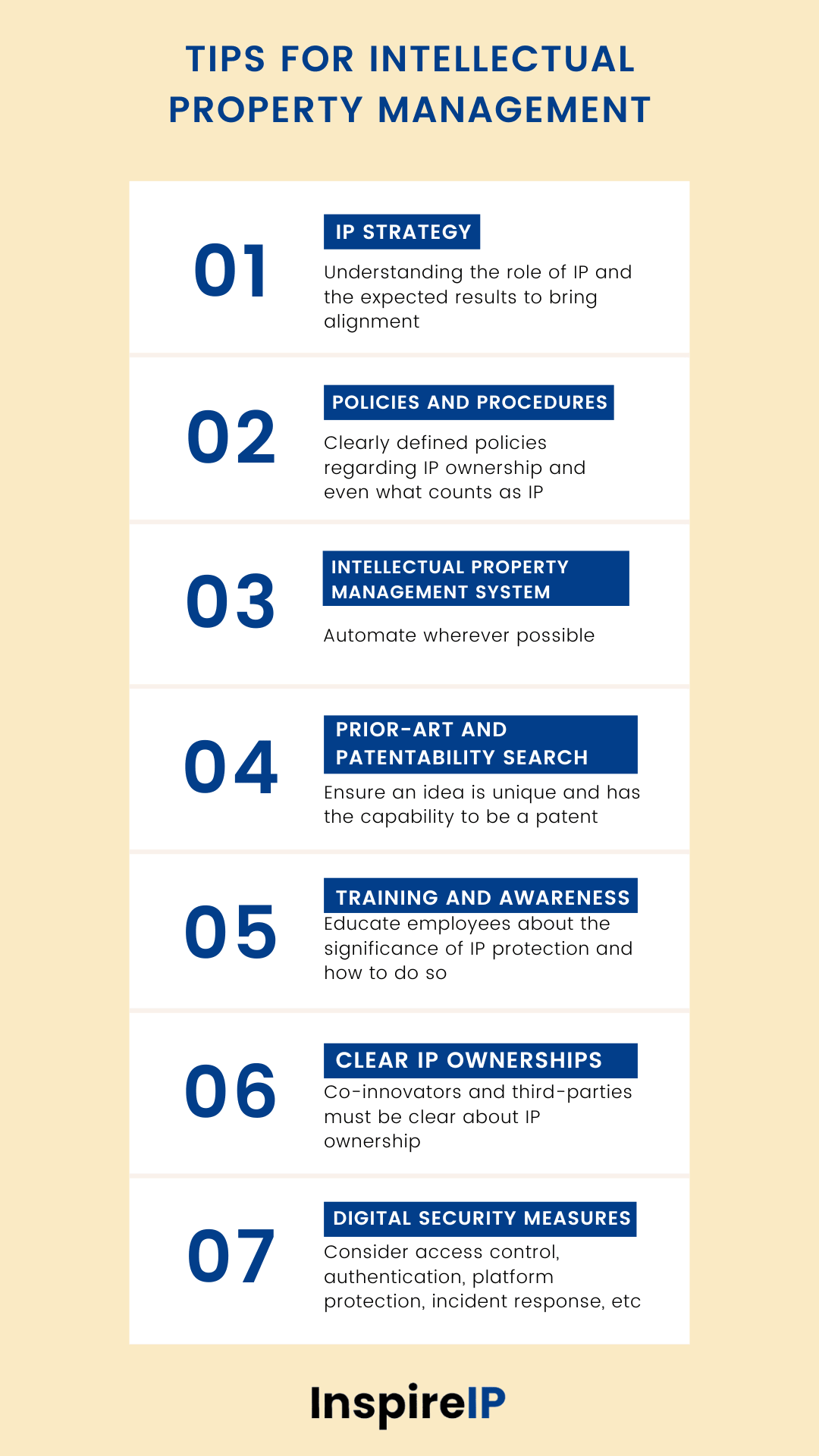Do you know what’s common between Nike, Nokia, Yahoo, TiVo, and even Xerox?
They’ve all at one point or another failed to manage their intellectual property and fallen to patent-related lawsuits.
Although the market has never been forgiving, today’s hyper-competitive global landscape demands organizations look after their intellectual property. And investing in intellectual property management is now an integral part of the overall organizational growth planning.
So, let’s dive straight into the intellectual property management best practices and IP management tips.
Tips for Intellectual Property Management
#1 Define an IP strategy that aligns with your business objectives
Let’s say a company bases its appraisal system on the number of ideas and inventions a person submits, especially the R&D department.
The company might receive a pile of ideas, which is technically a good sign. It means people are utilizing their innovation side and participating in your innovation process.
But is this innovation strategy necessarily bringing you high ROI and a healthy patent portfolio?
If your target is a high number of patents getting filed, pursued, or commercialized, is the actual data still high? Often, there’s a gap between the IP strategy and business objectives that can be covered through IP management.
Start by focusing on:
- Understanding how intellectual property can play a pivotal role in advancing the company’s mission, strengthening its market position, and sustaining a competitive edge. And establishing the expected results from intellectual property management.
- Performing an IP audit to identify and assess existing intellectual property assets. This includes patents, trademarks, copyrights, trade secrets, and any other proprietary information.
- Bringing every individual on board with the innovation strategy that ultimately builds the IP strategy.
- Incorporating ethical considerations in the management of intellectual property, including responsible use of patents, trademarks, and copyrights.
- Ensuring that the organization’s intellectual property practices comply with relevant laws and regulations. Staying informed about changes in IP laws and adapting the strategy accordingly.
#2 Establish basic policies and procedures for IP protection
Once you are through with a thorough examination of your intellectual property landscape through a comprehensive IP audit. Identify and understand all existing assets, ranging from patents and trademarks to copyrights and trade secrets. This foundational step sets the stage for crafting tailored protection measures.
Your company’s intellectual property—employee ideas, invention disclosures, patents, trade secrets—are your biggest assets and demand standardized policies and procedures for IP protection.
Clearly defined policies regarding IP ownership and even what counts as IP must be communicated well to all the employees within the organization.
This communication whether the company or individuals hold the rights to inventions, creative works, and other intellectual property helps in avoiding disputes and ensures a transparent framework.
Incorporate confidentiality and non-disclosure agreements into your policies. Make it mandatory for employees and relevant stakeholders to sign such agreements, outlining their obligations to keep sensitive information confidential. This serves as a fundamental layer of protection.
Establish procedures for employees to disclose new inventions promptly. Develop a structured process for filing invention disclosures, ensuring that potential patentable inventions are identified, evaluated, and appropriately documented.
This brings us to the next point.
#3 Establish an intellectual property management system
That you have an established IP management committee or team is not going to be enough. For scalability and dedicated IP growth, you need IP portfolio management software for your organization.
Essentially, automate wherever possible with digital platforms. It helps you streamline the entire IP lifecycle and reduce manual errors.
For example, when you use traditional processes, such as email, paperwork, spreadsheets, and so on, it is almost impossible to establish stakeholder engagement and collaboration.
You lose out on a well-functioning process and details are easily lost.
A dedicated software also help set clear guidelines for documenting and recording all IP-related activities. Proper documentation is essential for establishing ownership, proving prior art, and supporting patent applications. This meticulous record-keeping enhances the organization’s ability to defend its intellectual property.
To selecting an intellectual property management system, you must review:
- The scalability, flexibility, and adaptability of the system.
- The availability of integrations and automations.
- The pricing system of the intellectual property management system.
Use IP management software that provides accuracy in tracking your intellectual property assets.
But we know it can get expensive! Those heavy lifting solutions are good, but not feasible for every company.
There’s a solution! Harness the power of both strategic invention disclosure software and big old portfolio management systems, such as IPfolio and Symphony, with integrations.
#4 Conduct exhaustive prior-art and patentability search
The most fundamental step in IP management is continuously and thoroughly searching prior arts and patentability options before investing time and resources. Getting into the thick of it and developing something new that didn’t turn out to be novel can be disheartening and demotivating.
Therefore, start with a prior-art search.
Since we already talked about having an automated system, they already provide you AI-powered searches. For instance, InspireIP offers PQAI feature to help you with prior-art searches.
When you have a novel idea, perform a quick patent search and ensure that the idea is uniquel with no potential IP infringements.
#5 Training and Awareness
Implementing effective training programs to educate employees about the significance of Intellectual Property (IP) protection is essential for fostering a culture of awareness, responsibility, and compliance within an organization.
These programs also help recognize which intellectual property assets they’ve got and must be disclosed in order to protect them right from the beginning.
If all employees understand what needs to be protected, they can get onboard with the policies, procedures, and platforms you’ve established to protect your IP.
The training program can kick off by delving into the world of IP. Employees learn about the different forms of intellectual property, from patents safeguarding innovations to trademarks protecting the company’s brand identity.
The training then must focus on the pivotal role IP plays in the organization’s success. Employees hear compelling stories about tech companies that effectively protected their IP, leading to market dominance, revenue growth, and sustained innovation. This segment aims to convey the tangible impact of IP protection on the company’s future prospects.
The emphasis is on personal responsibility – every team member contributes to maintaining the confidentiality and integrity of the company’s intellectual property. This interactive discussion fosters a sense of collective ownership and accountability.
A hands-on approach encourages active participation and enhances retention of key principles.
A significant component of the program revolves around compliance with IP laws and regulations. The goal is to empower employees with the knowledge needed to navigate the legal landscape surrounding intellectual property.
The training mustn’t end with a one-time session. It includes regular updates and refresher courses to keep employees informed about evolving IP protection practices, industry trends, and changes in relevant laws. A continuous evaluation process, incorporating feedback mechanisms and quizzes, ensures that the training remains effective and responsive to employee needs.
To motivate employees further, the company introduces an incentive program. Recognizing and rewarding exemplary compliance with IP protection policies becomes part of the organizational culture, reinforcing the value placed on intellectual property.
#6 Ensure inventions with co-Inventors have clear IP ownerships
This step must come before collaboration begins. Every co-innovator must be clear about their IP ownership. This also stands true to businesses bringing in experts and third parties to work on all aspects of business development. It can be as simple as developing technical or training guides.
It provides clarity and transparency. The contract must reflect that you own any IP generated through collaboration.
Here’s how you can navigate this process:
- Clear IP Ownership Agreement: Draft a comprehensive agreement that clearly outlines the ownership rights of each co-inventor. This agreement should specify the percentage of ownership or the specific contributions of each inventor to the invention.
- Define Contributions: Clearly define and document the specific contributions of each co-inventor to the invention. This may include delineating the role of each inventor in the conception, development, and implementation of the invention.
- Timely Invention Disclosure: Utilize a professional yet secure medium to implement a process for timely invention disclosure. Ensure that all co-inventors promptly disclose their contributions to the invention, and save this information in a centralized system.
- IP Ownership Clauses in Employment Contracts: If the co-inventors are employees of the same company, include clauses in their employment contracts specifying the company’s ownership of inventions created during the course of their employment. Ensure these clauses are clear and align with local laws.
- Legal Review: Seek legal advice to review the IP ownership agreement and ensure that it complies with relevant intellectual property laws. Legal professionals can provide guidance on the enforceability of the agreement and help avoid potential disputes.
#7 Implement digital security measures
Incorporating the digital age, don’t forget to include a module on technology-related aspects of IP protection. Employees must learn about secure handling of digital assets, cybersecurity measures, and best practices for protecting intellectual property in the digital realm.
It’ll help prevent unauthorized access, distribution or reproduction of your IP assets. Key digital security measures to consider:
- Access Control: Implement robust access control mechanisms to restrict access to IP-related data and systems. Assign specific access permissions based on job roles, ensuring that only authorized personnel can view or modify sensitive information.
- User Authentication: Enforce strong user authentication practices, such as two-factor authentication (2FA) or multi-factor authentication (MFA), to add an extra layer of security when accessing IP management systems and databases.
- Regular Software Updates: Keep all software, including IP management applications and related tools, up to date with the latest security patches. Regularly update operating systems, antivirus software, and any third-party applications to address vulnerabilities.
- Data Backups: Regularly back up IP-related data and ensure that backup systems are secure. In the event of data loss or a security incident, having up-to-date backups can help restore information and minimize the impact.
- Incident Response Plan: Develop and implement an incident response plan that outlines the steps to be taken in the event of a security breach. This plan should include communication protocols, containment procedures, and steps for recovery.
- Regulatory Compliance: Ensure that digital security measures align with industry-specific regulations and compliance standards. Stay informed about changes in relevant laws and update security practices accordingly.
In Conclusion
Here’s a printable conclusion to always keep you on your toes for your successful intellectual property management.




